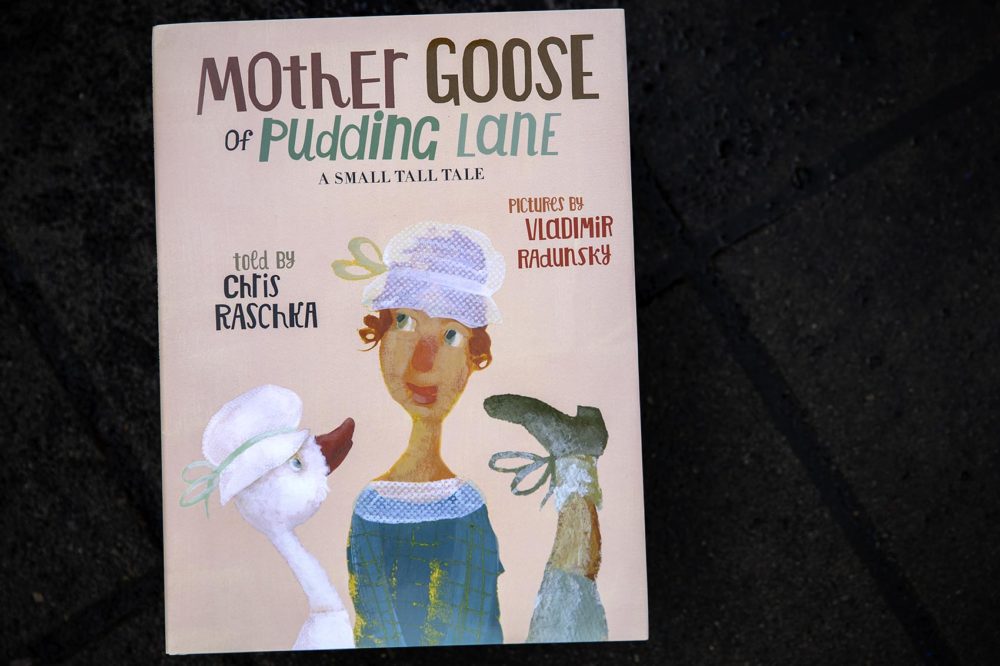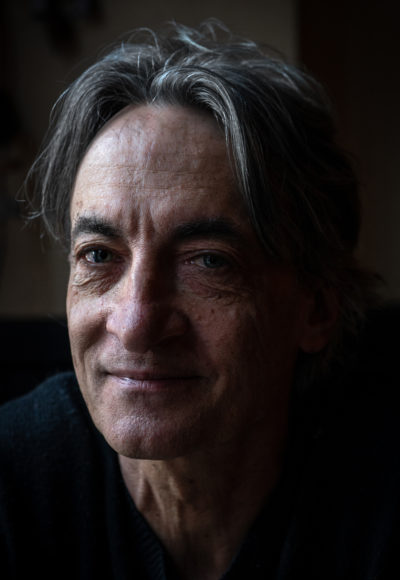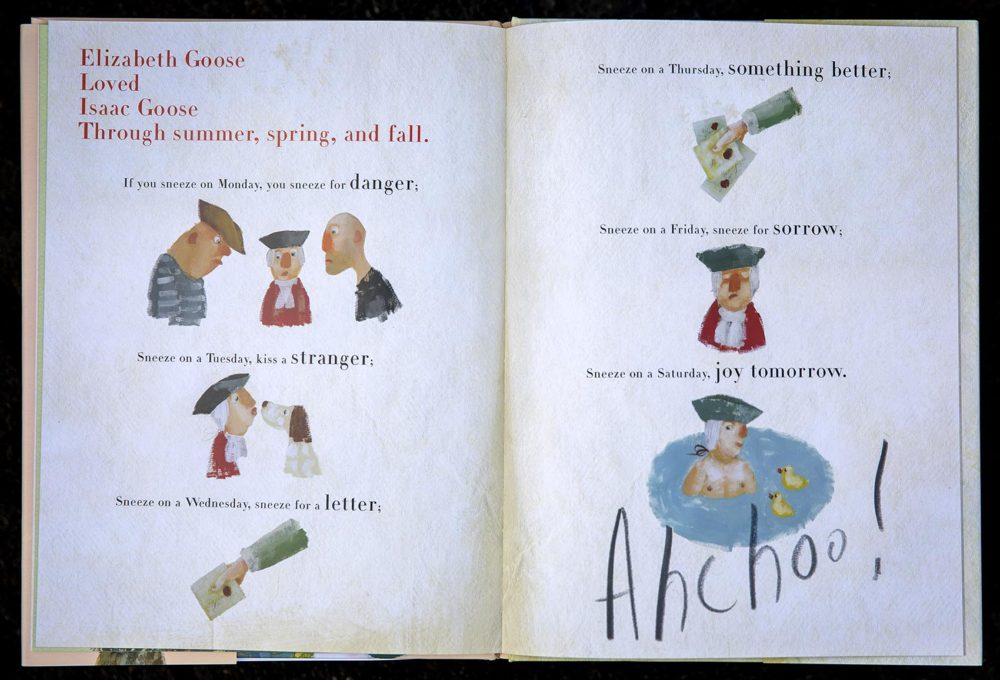Advertisement
'Mother Goose Of Pudding Lane' Tells The Story Of A Real Mother Goose In Boston

“Anyone who rhymes a little story is a kind of goose. Anyone who cares for little children is a kind of mother. Do them together and you are a kind of Mother Goose.”

This is the premise of the new, quintessentially New England children’s book by Chris Raschka, "Mother Goose of Pudding Lane," enlivened by quirky, delightful illustrations by the late Vladimir Radunsky and published by Somerville-based Candlewick Press.
In artfully abstracting the concept of Mother Goose, Raschka pre-emptively acknowledges that there was no single author of the myriad rhymes and songs that have passed through the century as “Mother Goose rhymes.”
“The Mother Goose poems are a kind of canon of poetry that has grown over centuries in a number of countries, mostly England and France,” Raschka explains. “From what I have read, there is no person who is the Mother Goose, as there is a Hans Christian Andersen or Aesop.”
But there was a Boston-based Mother Goose, a young woman named Elizabeth Foster who married a Boston-based widower with 10 children, Isaac Goose, in 1692. (Mary Balston Goose, Isaac’s first wife, is buried in the Granary Burying Ground, and for years was wrongly declared to be the “real” Mother Goose — a legend that drew countless visitors to her grave.) The slender story of Elizabeth and Isaac’s romance, marriage and mothering — which Raschka has written in the style of Mother Goose — serves as the organizing structure for this collection.
Bouncy, occasionally romantic, often silly, the rhymes range from the familiar to the obscure. All are meant to be sung or read aloud to children. And what child isn’t delighted to hear “All work and no play makes Jack a dull boy” (as long as it isn’t being recited by a scarily demented Jack Nicholson), even if it’s followed by the far-less famous second stanza, “All play and no work makes Jack a mere toy.”
Many are sneakily instructive. Some teach children the days of the week (“If you sneeze on Monday, you sneeze for danger. Sneeze on a Tuesday, kiss a stranger. Sneeze on a Wednesday, sneeze for a letter. Sneeze on a Thursday, something better. Sneeze on a Friday, sneeze for sorrow. Sneeze on a Saturday, joy tomorrow.”) One, in Raschka’s favorite spread, teaches the annual calendar via charming illustrations and rhyming couplets about the implications of getting married in each month of the year. (“If you wed in bleak November, only joys will come, remember.”)

Romance and marriage are a surprisingly dominant theme of the book. But as Raschka explains, “As I was working with the Pudding Lane legend of Mother Goose, I had to work with the characters in that legend. At the same time, Mother Goose rhymes cover a huge range of content, from nonsense to broad political themes, and much of it is romantic. The poems lend themselves to a love story. Mother Goose rhymes have also been the object of condemnation by various moralists, especially in the 19th century. One of my earlier versions was a riff on Mother Goose as a figure in a FBI Most Wanted list.”
That image — contemporary and irreverent — would not have been out of place in this marvelously illustrated book. Colorful but not garish, layered but not murky, Vladimir Radunsky’s pictures — which appear to have been created in gouache on textured, different colored paper — are engaging and often funny. Hats and bonnets from the 17th century adorn faces with big noses and surprisingly expressive eyes. Naked feet protrude from under blankets and nightshirts. A stylishly-garbed pig with top-hat and cane fills most of the page with one of Raschka’s favorite rhymes (“A little pig found a fifty-dollar note and purchased a hat and a very fine coat …”). Babies stare down mockingbirds and billy goats; one rides, gets ridden by, and bathes with a pig. And one of the final spreads, on which “Elizabeth Goose and Isaac Goose at last grew old and gray,” features pale, blurred, almost transparent images of the couple that are as poignant as they are lovely.
“Working with Vladimir has been one of the great joys of my working life,” Raschka says of his longtime friend and collaborator, with whom he jointly illustrated two prior books. Radunsky died in late 2018, and in his New York Times obituary Raschka described Radunsky’s artistic approach in this book as “beautiful portraits” interspersed with “perfectly childlike” doodles that “only a trained artist could make.”
Those quirky, believable penciled doodles came almost as an afterthought.
“Vladimir added these after all the art was complete,” Raschka explains, “feeling that the book needed something more … Vladimir always tried to skewer any sniff of self-importance in art or illustration, which these very effectively do.”
Indeed, they transform an already visually delightful book into something that kids can and undoubtedly will feel empowered to make their own. "Mother Goose of Pudding Lane" invites its readers to sing it, dance it, and scribble all over it. What loftier goal than that can a children’s book achieve?
